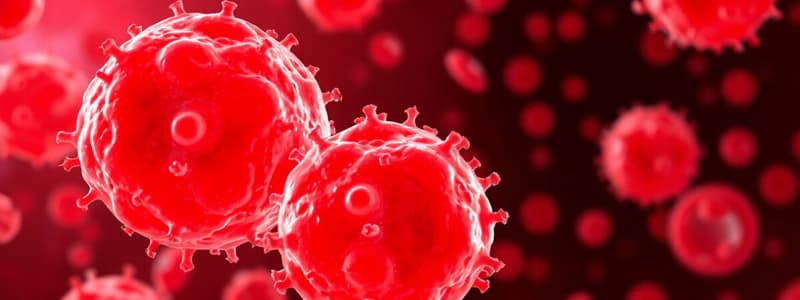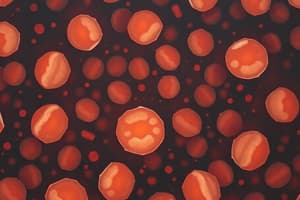Podcast
Questions and Answers
What primarily characterizes acute leukemias?
What primarily characterizes acute leukemias?
- Increased production of red blood cells
- Presence of undifferentiated white blood cell blasts (correct)
- Presence of mature white blood cells
- Abnormal levels of mature lymphoid cells
Which biochemical test is NOT typically increased in both types of acute leukemias?
Which biochemical test is NOT typically increased in both types of acute leukemias?
- Uric acid levels
- Platelet load (correct)
- Lactate dehydrogenase (LDH)
- White blood cell count
What type of cell do leukemias predominantly involve?
What type of cell do leukemias predominantly involve?
- Neutrophils
- Erythrocytes
- Malignant white blood cells (correct)
- Platelets
Which condition is commonly associated with acute lymphocytic leukemia (ALL)?
Which condition is commonly associated with acute lymphocytic leukemia (ALL)?
What is a defining feature of chronic leukemias?
What is a defining feature of chronic leukemias?
In acute myeloid leukemia (AML), what cells are mainly absent?
In acute myeloid leukemia (AML), what cells are mainly absent?
What is a general outcome of both acute leukemias and chronic leukemias?
What is a general outcome of both acute leukemias and chronic leukemias?
Which type of blood cell is primarily affected by leukemia?
Which type of blood cell is primarily affected by leukemia?
What is the primary function of hemoglobin in red blood cells?
What is the primary function of hemoglobin in red blood cells?
Which classification corresponds to red blood cells that are larger than normal due to an increase in volume?
Which classification corresponds to red blood cells that are larger than normal due to an increase in volume?
Which component of hemoglobin is critical for its ability to bind oxygen?
Which component of hemoglobin is critical for its ability to bind oxygen?
What is the consequence of decreased levels of iron in red blood cells?
What is the consequence of decreased levels of iron in red blood cells?
What mechanism regulates the absorption of iron in the intestines?
What mechanism regulates the absorption of iron in the intestines?
What laboratory measurement indicates the average concentration of hemoglobin in a volume of red blood cells?
What laboratory measurement indicates the average concentration of hemoglobin in a volume of red blood cells?
Which of the following symptoms is NOT typically associated with anemia?
Which of the following symptoms is NOT typically associated with anemia?
What is the primary role of transferrin in the body?
What is the primary role of transferrin in the body?
What is the primary feature of chronic lymphocytic leukemia (CLL)?
What is the primary feature of chronic lymphocytic leukemia (CLL)?
What is a definitive diagnostic method for chronic myeloid leukemia (CML)?
What is a definitive diagnostic method for chronic myeloid leukemia (CML)?
Which statement about lymphomas is correct?
Which statement about lymphomas is correct?
What is a common early symptom of Hodgkin lymphoma?
What is a common early symptom of Hodgkin lymphoma?
How are the two major types of lymphoma differentiated in terms of their cellular origin?
How are the two major types of lymphoma differentiated in terms of their cellular origin?
Which laboratory finding is specifically associated with chronic myeloid leukemia (CML)?
Which laboratory finding is specifically associated with chronic myeloid leukemia (CML)?
What is a significant laboratory consideration for the diagnosis of both CLL and CML?
What is a significant laboratory consideration for the diagnosis of both CLL and CML?
In early-stage lymphomas, what might clinical tests reveal?
In early-stage lymphomas, what might clinical tests reveal?
What laboratory finding is typically elevated in pernicious anemia due to increased hemolysis?
What laboratory finding is typically elevated in pernicious anemia due to increased hemolysis?
Which type of anemia is characterized by microcytic red blood cells and low mean corpuscular volume (MCV)?
Which type of anemia is characterized by microcytic red blood cells and low mean corpuscular volume (MCV)?
In thalassemia, the severity of anemia is primarily dependent on what factor?
In thalassemia, the severity of anemia is primarily dependent on what factor?
What is the typical classification of anemia associated with chronic diseases?
What is the typical classification of anemia associated with chronic diseases?
Which test is not typically used to diagnose iron-deficiency anemia?
Which test is not typically used to diagnose iron-deficiency anemia?
What condition is characterized by the presence of the abnormal hemoglobin S (HbS)?
What condition is characterized by the presence of the abnormal hemoglobin S (HbS)?
Which of the following is a laboratory finding associated with chronic inflammation?
Which of the following is a laboratory finding associated with chronic inflammation?
What is the primary cause of increased hemolysis in sickle cell anemia?
What is the primary cause of increased hemolysis in sickle cell anemia?
Which type of anemia is specifically tied to autoimmune destruction of cells that produce intrinsic factor?
Which type of anemia is specifically tied to autoimmune destruction of cells that produce intrinsic factor?
In the evaluation of a patient with suspected sickle cell anemia, which test would be most informative?
In the evaluation of a patient with suspected sickle cell anemia, which test would be most informative?
Flashcards are hidden until you start studying
Study Notes
White Blood Cell Disorders
- Leukemia and lymphoma are two major divisions of white blood cell diseases.
- Leukemias are malignant diseases of the bone marrow and blood that involve abnormal, nonfunctional white blood cells released into circulation.
- Acute leukemias involve undifferentiated (blasts) white blood cells in circulation.
- Chronic leukemias involve immature white blood cells in circulation.
- Lymphoma is a malignancy of the lymphatic system originating from abnormal B or T cells.
- Hodgkin lymphoma originates from abnormal B cells and involves Reed-Sternberg cells.
- Non-Hodgkin lymphoma originates from abnormal B or T cells and is more common than Hodgkin lymphoma.
Acute Leukemias
- Acute lymphocytic leukemia (ALL) is the most common type among children and adolescents and involves lymphoid precursors proliferating and replacing normal cells.
- Many patients with ALL have disseminated intravascular coagulation (DIC), leading to bleeding.
- Laboratory considerations for ALL include neutropenia, anemia, thrombocytopenia, and increased lactate dehydrogenase (LDH) and uric acid levels.
- Acute myeloid leukemia (AML) involves abnormal myeloid cell precursors with no mature myelocytes, red blood cells, and platelets.
- Abnormal cells accumulate in the bone marrow, blood, spleen, and liver.
- Laboratory considerations for AML include neutropenia, anemia, thrombocytopenia, increased LDH and uric acid levels, and require a bone marrow biopsy for diagnosis with at least 20% blasts.
Chronic Leukemias
- Chronic lymphocytic leukemia (CLL), most common in adults of Western countries, involves small, nonfunctional lymphocytes.
- It may be asymptomatic for years.
- Laboratory considerations for CLL include no specific clinical biochemical tests for diagnosis or confirmation, and a bone marrow biopsy and flow cytometry might be used for diagnosis.
- Chronic myeloid leukemia (CML) involves increased granulocytes in the bone marrow.
- It accounts for 20% of all adult leukemias.
- Laboratory considerations for CML include elevated uric acid levels and the Philadelphia (PH 1) chromosome translocation in bone marrow cells as a diagnostic hallmark.
Lymphomas
- Hodgkin lymphoma involves single painless lymph nodes in the cervical region as the first symptom.
- Non-Hodgkin lymphoma involves peripheral lymph nodes increasing in size.
- Peripheral blood tests are not helpful for diagnosis.
Red Blood Cells
- Anemia is a deficiency of red blood cells or hemoglobin in the blood, impairing oxygen transport and causing symptoms like weakness, dizziness, pale mucous membranes, lightheadedness, and tachycardia.
- Anemias are classified based on the size and shape of red blood cells (microcytic, normocytic, macrocytic) and the amount of hemoglobin (hypochromic, normochromic, hyperchromic).
Anemia - Basic Concepts
- Hemoglobin is a globular protein transporting O2 and CO2 and is the major structural protein of the red blood cell.
- Each of the four globin chains has a molecule of heme.
- Iron is a vital component of hemoglobin, found in myoglobin and stored in tissues and enzymes.
- Iron absorption is regulated by a negative feedback loop.
- Iron must be transported to the liver for heme synthesis using transferrin.
- Iron is stored in ferritin (liver, spleen, and bone marrow).
- Heme is a molecule composed of porphyrin and an iron atom.
- The oxygen molecule binds to the heme group.
- Most heme is synthesized in developing red blood cells in the bone marrow.
- The heme created by red cells is used to synthesize hemoglobin.
- Heme is also found in cytochromes in mitochondria.
Anemia and Diagnostic Tests
- Iron-deficiency anemia is a type of microcytic anemia with low MCV, resulting from insufficient iron for red blood cell production.
- Laboratory considerations for iron-deficiency anemia include low hemoglobin, hematocrit, MCH, MCHC, and high RDW.
- Additional tests like iron level, total iron binding capacity (TIBC), and ferritin are required for diagnosis.
- Pernicious anemia is a macrocytic anemia caused by vitamin B12 deficiency due to an autoimmune disease destroying stomach cells that produce intrinsic factor.
- Laboratory considerations for pernicious anemia include markedly increased LDH levels and elevated indirect (unconjugated) bilirubin values.
- Sickle cell anemia is a consequence of sickle cell disease, an inherited blood disorder with a mutation in the hemoglobin gene.
- Homozygous HbS results in sickle-shaped red blood cells due to HbS molecules sticking together.
- These cells are destroyed in the spleen, leading to chronic anemia.
- "Hemolytic crisis" causes rapid hemolysis and elevated unconjugated bilirubin levels.
- Laboratory considerations for sickle cell anemia include sickling tests and electrophoresis.
- Thalassemia is a group of inherited blood disorders with mutations in genes encoding alpha/beta-globin chains in hemoglobin.
- The severity increases with the number of affected genes.
- Laboratory considerations for thalassemia include decreased hemoglobin levels, reduced RBC count and size (MCV), hemoglobin electrophoresis, and genetic testing for specific mutations.
- Anemia of chronic diseases (or chronic inflammation) is a normocytic, normochromic anemia associated with chronic disorders like rheumatoid arthritis, diabetes mellitus, and heart disease.
- Laboratory considerations for anemia of chronic diseases include decreased overall RBC count, iron levels, erythropoietin production, and shortened red blood cell lifespan.
Clinical Importance of WBC count with Differential - Leukemia and Lymphoma
- A component of the complete blood count (CBC), it is essential for initial diagnosis (e.g., increased WBC count and abnormal differentials), subtype classification, disease monitoring, detection of complications (e.g., anemia, infections, bleeding disorders), treatment adjustment, assessment of response to therapy, and identification of recurrence.
- CBC helps to determine the initial diagnosis of leukemia, including increased WBC count and abnormal differentials.
- It also assists in subtype classification, disease monitoring, and detection of complications like anemia, infections, and bleeding disorders.
- CBC facilitates treatment adjustment and assessment of response to therapy, as well as identification of recurrence.
Studying That Suits You
Use AI to generate personalized quizzes and flashcards to suit your learning preferences.




